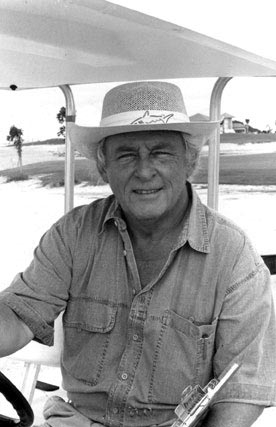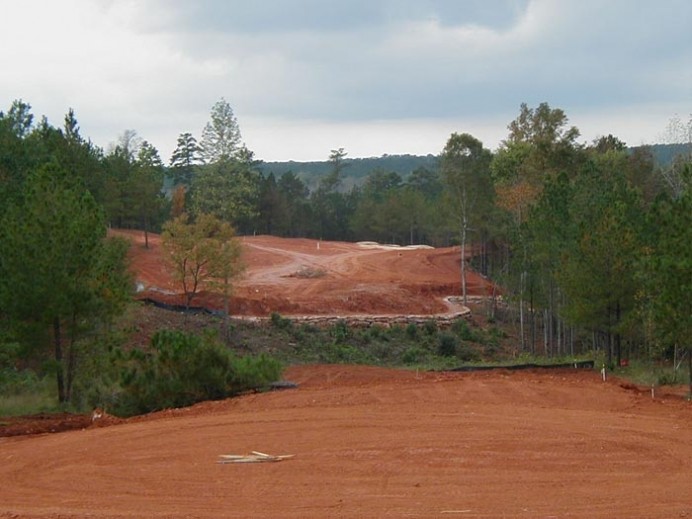Feature Interview with Roy Case
February, 2008
Born in Great Britain, how did you come to live in Kingston, Jamaica for fifteen years?
In the early 60’s I had completed my studies in both Architecture and Town Planning, served three years as a Flying Officer in the RAF, and had placed third in an international architectural competition, together with three students from my former school .We started a practice together, based upon that success, which began to do well. Then came the winter of 1962 when the Thames froze over, and railways were seriously impacted by frozen points. Buildings were not designed for such conditions and it was a miserable experience. Taxes were high, and promised to go even higher. My knowledge of geography convinced me that winter was unnecessary, so I visited the Crown Agents, who represented former Commonwealth nations, in their search for professionals who were willing to travel. I interviewed for two jobs, one in Kenya and one in Jamaica. I was offered both, so I spun a coin and it came up ‘Heads’ which was Jamaica. So I became a Government employee in Kingston.
What brought you to the United States?
During my time in Jamaica I had become a high profile person, thanks to my ventures into broadcasting, both radio and TV, mainly in sports, and an acting career which included many local productions and a part in a BBC series ‘The Fight Against Slavery’ Guns had become prevalent in Jamaica and some fell into the hands of people who were trophy hunting. A number of my friends were killed, and my wife, who is Jamaican, said she could not take the strain any more and, as she had a green card, proposed to leave for the USA, and hoped that I would do the same. I had obtained a green card through getting one for our daughter, so the way was clear. I had never considered leaving Jamaica – I had become a citizen, and had reached the stage where did not have to work full time, and could pursue my interests, including golf, while doing consulting work in the real estate development field. Added to this the Jamaican Government had established a rule to try to stem the ‘brain-drain’ that was going on at he time, by mandating that you could only take out US$50.00. At that time it was also illegal to own US currency. So it was quite a wrench, leaving behind my ideal life, and my real estate portfolio and becoming an impoverished refugee. But, as my wife said, “Better to be alive and poor than rich and dead” She never had any doubt that we would survive. Luckily my wife had relatives in New York, and I was able to stay with my first wife and her husband in Plantation Florida. I smuggled out $3,000.00, and my sister in law brought out a similar amount a couple of months later, inside a box of baby powder, as part of the proceeds of the sale of one of my properties. I eventually found an apartment for $250.00 per month and we were able to reunite the family in Florida, sleeping on mattresses on the floor, but happy to be safe, and warm…
What was your first solo course? When was that built?
My first routing plan was done for Rose Hall Estates in Jamaica. My firm was the Planning Consultant for the Estate, which at that time only had the RTJ Senior course. I routed their second course which was called the Intercontinental Course, later The Wyndham course, and now Cinnamon Hill. The course has been redone but the routing is unchanged. My first course in the United States was Cobblestone, in Palm City FL .That course opened in 1989 and in 1990 it was rated by Golf Digest in the top ‘Fifty Most Distinctive Development Course in the Southeast United States’ .The course was bought recently by a group headed by Darren Clarke. It is now called ‘The Fox’ and is an all male club. The course has been lengthened but the routing is unchanged.
Over the ensuing years, what changes have you seen in your profession for the good? For the bad?
For the good- architects have got closer to nature in their work. Also there seems to be less ‘torture by golf’ type design, although I did visit a course recently that had a slope rating of 157!. For the bad- hard times seem to have brought out the worst in designers. I have had two jobs stolen from under my nose by unscrupulous fellows who promise far more than they can deliver, at prices that mean they can hardly survive. Also for the bad I discovered that as an Englishman who has lived and worked and paid taxes in the USA for over thirty years, I am not eligible for membership of the ASGCA unless I am American or Mexican!! In a country that prides itself in ethnic diversity I find this astonishing, from a Learned Society.
What trends would you like to see take hold now?
The trend toward the natural look. I hope it gains strength.
What trends in golf course architecture have you seen come – and then mercifully go?
A trend in the 80’s when architects seemed to be vying for the most expensive, and over-designed, course. The trend away from manufactured golf toward more natural looks is very welcome. Some courses looked as if they were designed to be photographed, rather than played. I think the ultimate in bizarre was Stone Harbor, based upon Greek mythology, and rampant with bulkhead work. It graced the pages of a prominent golf magazine, and earned the cancellation of my subscription!
How can golf course architecture influence the health of the sport?
We have to realize that there are two distinct worlds in golf; Professional Tour Golf, (1%), and Real Golf,(99%). Real Golf is played every day of the year by millions of golfers, and is the foundation of the industry. It could continue to flourish without Professional Tour Golf, but the reverse is not true. Unfortunately, from a design standpoint, the advent of wide TV coverage of Professional Golf has given the average golfer a skewed look at the sport, and what to expect of the golf course. Distance is king, and perfect playing conditions are to be expected. The thing that keeps the millions playing is the intrinsic enjoyment of the challenge of the game, and it is up to us, as designers, to nurture that. Our Mantra-“Golf is a game, games are to be enjoyed, golf is to be enjoyed.” Most courses should be designed for those who play them. Design from the middle tees with comfortable landing areas and green complexes that give the player a chance to get up and down from off the putting surface. Despite modern technological advances the average golfer seldom hits the ball more than 220 yards and seldom hits more than four or five greens in a round. That is reality, and designers should be keenly aware of that. The easiest course to design is a difficult one, where the designer gives free rein to his creative thoughts. But the skill and subtlety required to design a course that the average golfer can enjoy, play in a reasonable time, with enough variety and interest to bring him back many times over is extremely hard to capture. We should also give special consideration to women golfers and seniors, they both contribute a lot to the success of a golf operation. This is the area where professional golfer/designers generally fail miserably, they cannot connect with average golfers and provide enjoyable golf for them It is far more important to design a course that people enjoy playing, than it is to get one featured in a golf magazine!!.If we can provide recreation that people can enjoy the game will grow.
Do you even try and combat the advances that technology has made for the top 1% of golfers?
We cannot ignore reality, but let us not get carried away. If the claims by manufacturers were true then all the five, ten and fifteen percent increases every year in ball flight would mean that the average golfer would be hitting the ball close to 300 yards off the tee with amazing accuracy and control! So much for advertising! As I have said above, the advances have helped the average golfer but not enough to cause major design changes.. .
The move to lengthen courses benefits only that one percent or so who are above average in ability, and does not relate directly to Real Golf. It is nice to say that your home course is over 7000 yards from the back tees, but in reality that does not do much for the average golfer. For most courses the addition of some ‘Trophy Tees’ can suffice for club or public golf., but if you are designing a tour course you must be prepared to accommodate tee shots of over 300 yards, and defend greens and target areas to a higher standard.
Please describe a particular hole that you have designed and what you like so much about it.
A simple hole that has stood the test of time is the second hole on the Eagle nine at Okeeheelee G.C, a 27 hole public course in West Palm Beach FL, that will host it’s 1,000,000th round some time this year, it’s thirteenth year of operation. It is a short par three that plays only 119 yards from the middle tees. The elevated green is deep and narrow, set at a slight left to right diagonal, in order to preserve some particularly attractive cypress trees to the left and behind it. There is a bunker at the front right of the green and a collection swale running the length of the green behind that. A tree lined canal is to the right. Short rough is to left of and front of the green with under story to the left of that. Balls that just miss the green are findable and playable, requiring a variety of recovery shots. The green is fairly flat but pitched gently to receive the shot. Despite its short length a par is a welcome score here. It is a good looking hole that is full of intrigue.
You’ve become known as an expert in brownfield golf courses, with Links Magazine dubbing you the ‘Lord of the Landfills.’ Please describe the process of turning a landfill into a golf course.
I think that ‘title’ is most unfortunate. There are many other designers who have done great work on damaged land. Brownfield golf development is as much engineering as it is golf course design. The main theme is to preserve the closure methodology that has been employed and protect golf grass from methane gas, and from severe weather conditions. Most landfills are still active, with settlement and gas production a reality. Landfills are generally contoured and the increased elevation together with a soft soil cover tends to magnify bad weather conditions. In most cases the surface cannot be penetrated or modified and all shaping dirt has to be brought from off site. We usually surcharge all green sites, to compact them against settlement, and we install accelerated drainage systems to control run off and erosion. We then install a vented plastic liner under all greens to guard against methane intrusion and we have to make sure that our drainage and irrigation systems do not interfere with the gas collection and leacheate control piping. Landfills generally give great views and interesting changes of elevation that enhance the golf experience. There is a great deal of satisfaction in this major recycling process.
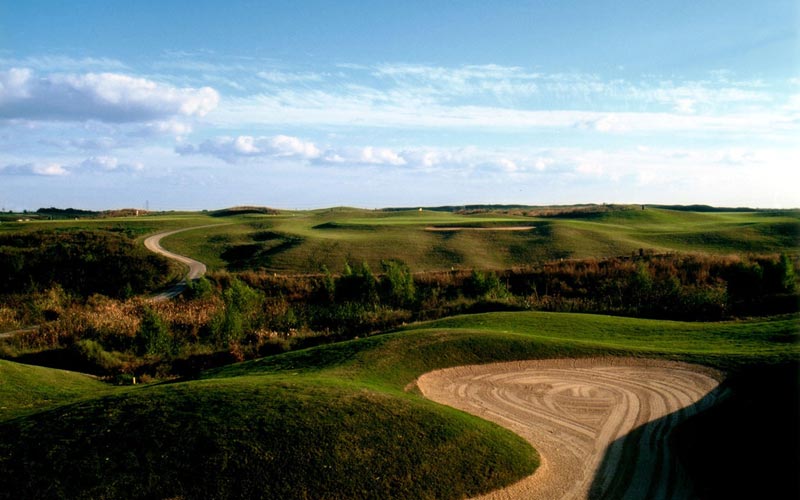
Born from a landfill, Wildcat in Houston provides great enjoyment to a number of golfers each year, in part due to its interesting elevation changes.
Park Ridge Golf Course in West Palm Beach, Florida is one of your landfill golf courses that opened in 2007 to rave reviews. Tell us about the golf course and what makes it different to other golf courses in south Florida.
Park Ridge is a great example of intergovernmental cooperation as it is a true joint venture between the owners, the Solid Waste Authority of Palm Beach County, and the County Parks and Recreation Department. It took 8 years to gestate and went through some hard times during construction, but has turned out to be very successful,l and will exceed it’s target of 50,000 rounds in it’s first year of operation. The main thing that sets it apart from other Florida courses is that there is a change of elevation of over 400 feet during the round, with a wide variety of uphill, downhill, and side hill playing areas. Also the hole breakdown of six 5’s, six fours, and six threes, is different. This was not predetermined, but that was the best use of the site. We have managed to make all the holes in each category different in form and character so the visual interest level stays high throughout the round, not to mention the long views available from the highest elevations. The back nine contains four par fives and three par threes for a par of 37. The course has a distinct links feel to it with few trees and natural tall grass areas separating the holes. I call it an “out-of-Florida” golf experience. I was not certain how the 6,6&6 would play time wise, but with 9 minute starting times the course flows smoothly in about 4 hours and 10 minutes. It seems that the local pros like to play the course at 6900+ yards, and I was delighted to be told by one lady that she had her best round ever there, 67, with seven birdies. The course is designed to be played hard and fast, with greens generally open at the front to encourage run-up shots. The greens are comfortably sized and, with a couple of exceptions, not heavily contoured, with many collection areas around them. Playability. and a fresh look, is the key to Park Ridge’s popularity.
Eric Bergstol has been praised for his design work at Bayonne Golf Club. What a lot of people may not know is that Eric’s primary business used to be construction, not golf. He hired you as the golf course architect for two of his first courses, Minisceongo and New Jersey National. Although he has hired and worked with other architects such as Tom Fazio, how do you feel you contributed to Eric Bergstol’s evolution as a designer?
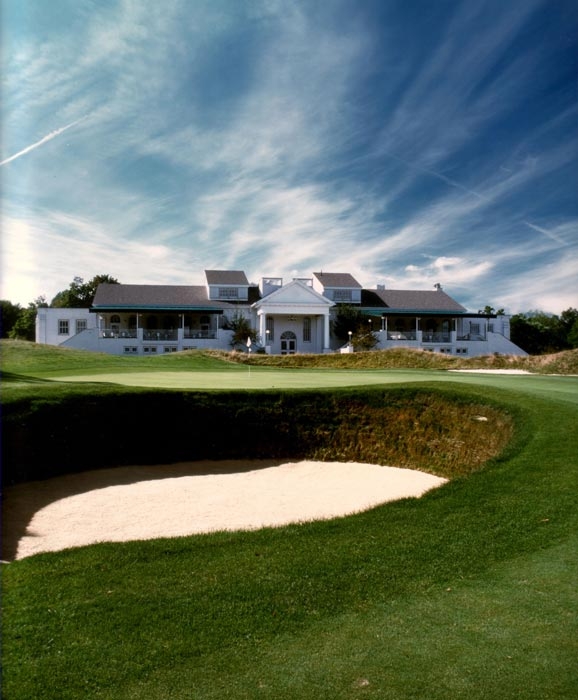
The eighteenth at Minisceongo, with its deep fronting bunker to be avoided at all costs.
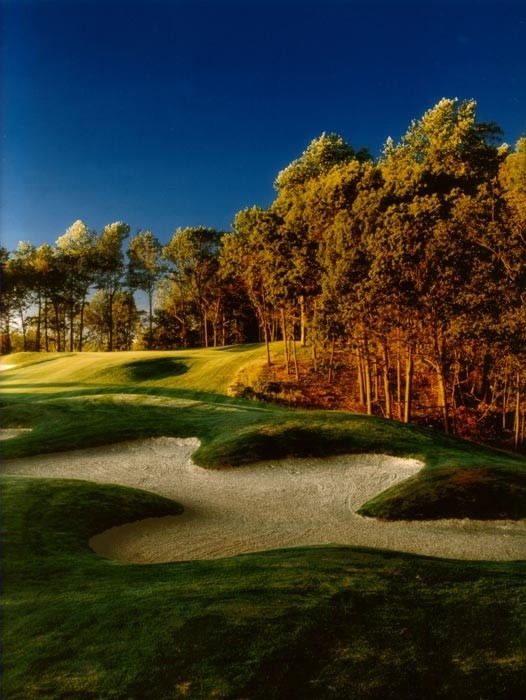
An uphill approach at New Jersey National.
Eric Bergstol and I go back a long way. He commissioned me to design Minisceongo after playing Cobblestone on the recommendation of a friend of his at the National Golf Foundation. It was my third job. As with all my work, I try to involve the client as much as he or she would like to be involved. With Eric the involvement was deep, as his company built the course. He lived close by, and I stayed at his house many times during site visits, so we had plenty of time to talk. Then came New Jersey National. That was a helter-skelter job against a tough time constraint, with drawings being completed the night before a site visit. Again, Eric was closely involved in all design decisions and, as with Minisceongo, there is a lot of Eric in the final form of the course. Eric is a builder and a fine golfer and it was no surprise to me when he started designing his own courses. We continued our dialogue during that period, building upon the constant exchange of ideas when we were working together, so I may have contributed a little to his progress as a designer. But Eric is a very strong and brave person who knows what he wants, and goes after it come hell, or high water. I don’t think any other individual would have had the “cohones,” knowledge and ability to take on Bayonne, and complete it. I have nothing but admiration for him.
Bayonne Golf Club has gotten a lot of attention over the past year or so, both as an engineering feat as well as for its spectacular look. You were involved in the project to a certain extent. Can you tell us about it?
Bayonne is on a very small site and the routing was very difficult to achieve the kind ofupscale course that Eric desired. So we helped finalize the routing and my partner, Jeff Grossman, visited the site during construction to help with some grading issues. It is not generally realized that Bayonne was a seven year project. The detailed golf course design is entirely Eric’s, and he has done a masterful job. I was glad we could contribute some basic work.
The Meadowlands project in New Jersey has received a lot of press over the years, with you being the golf course architect on record for the project since its inception in the late 1990s. Recently, it was reported that Donald Trump was becoming involved in the project and that he envisioned a Tom Fazio golf course on the site. Can you tell us about your involvement on the project from the beginning and where does it stand now?
I was involved with The Meadowlands from the very first. I had just completed Wildcat GC in Houston a 36 hole Landfill project for EnCap Golf, who decided they would respond to an RFP put out by the then Hackensack/ Meadowlands Development Commission. We were the outsiders among the respondents, with no local ties. However, we were the only group to present a plan and not ask for a lot of financial help, and we were the surprise selection. The initial plan was for 27 holes of golf with as much real estate development as possible. It soon became obvious that more development was needed to make the project financially viable, so the site was expanded a number of times and golf was increased to 36 holes with the idea that one course would be for the proposed Convention Hotel and the other for public access. As the project became more real estate driven the areas for golf were compressed until I cried “uncle.” This was, after all, an urban golf project, and the usual elbow room was not available, or could not be afforded. Most of the golf was sited on landfill cells and the permitting of it was a very protracted affair taking over 2 and a half years. As I have said above, the use of landfills for golf is as much an engineering feat as it is golf course design. We worked with engineers on a daily basis and my partner Jeff Grossman visited their offices in Maine a number of times when design issues and engineering were not readily compatible. These were generally slope stability and drainage issues. But we worked it out and got the site plans permitted with contours at five foot interval, with allowances for finishing layers. We had. no illusions about being the “Final Designers” although EnCap even went as far as assuring us that one course would be big name and one would be ours, an unlikely story. The project attracted a number of big developers who each had their own big name designer. Rees Jones, RTJ II, Nicklaus and Arnold Palmer all looked at the project, the first three decided there was only room for 27 holes after only a perfunctory look at the site; but the Palmer chaps took the time to look at our work in detail and decided they could accept the 36 hole routing plan. Unfortunately the potential hotel developer who was going to build the golf was not a fan of Arnold’s firm and insisted on Nicklaus. By that time 15 holes of our design had been shaped to the 5 foot contours and 100 new gas wells sited on the large cell that held twelve of the holes. The project has since fallen onto hard times, and I hear is about to be rescued by Mr. Trump. His choice is Mr.Tom Fazio, to do only 18 holes. The development of those holes and the permitting of them should be quite a task. Our involvement was a great learning experience and I had no regrets when the axe fell on our involvement, we had seen it coming for some time.
You’ve done golf course design projects with both Arnold Palmer’s and Sam Snead’s companies. Please talk about both relationships.
My involvement with the Palmer empire was through Jim Ellison the chief agronomist for the Management Company. Jim had seen my work at Minisceongo and when the Palmer Design Company got too busy to service the Management Company at the pace they needed, during their heavy acquisition period, he called on me. I did four projects for them culminating in 36 holes at Memphis National, these were my first experience of redo and rehab work and I was fascinated by the challenge of modifying a concept, increasing playability, and providing the quality visual experience that is the essence of golf. All the time keeping the flow of the experience going so that you could not tell the original holes from the new ones .I also got involved in responding to a couple of RFPs as part of their team. All in all it was a great experience, I did not get to work directly with Mr. Palmer, but did get to know him a little through being fellow speakers at various Seminars. I got to know him well enough to develop a great respect for him as I natural humanitarian. He is an amazing people person. Fame and adulation has not pulled his feet off the ground. He is a great man who respects and serves golf to his limit.
My relationship with Sam Snead was, with his son Jack and his wife Anne, trying to get a “Sam Snead Trail” going in his home State of Virginia. I am sorry to say that our efforts did not meet with success, We did a couple of great designs for State Park sites, but couldn’t get the funding to build them.
Getting to know Sam was a privilege. I found him to be quite unlike his reputation. He liked winning money from his “pigeons,” but he had a country warmth about him that was very engaging. He kept himself very fit and was proud of it. It is a pity that macular degeneration affected his eyesight in his later years. He had a ready wit and was a great storyteller. He was very fundamental in his approach to the game and the teaching of it. We were sitting watching some golf instruction on TV when he burst out laughing. The instructor had just finished listing eight swing keys that formed the basis of his theories. When I asked Sam why he was so amused he said “Roy, how many things can you think of, and do, in one and a half seconds?” His additionalcomments are not repeatable. His approach included “Hold the club like you would hold a bird. Tight enough to keep it in hand but not tight enough to hurt it.” “Swing at 80%.” Also, a wonderfully descriptive comment “There should be a moment of peace at the top of your backswing.” I feel very lucky to have known a great golfing legend. On the design side he felt it very important that players should enjoy the game and was insistent that every green should have a “bail out.” It is a great pity that we never managed to put his name on a course.
Before Donald Trump developed his golf resort on the island of Canouan in the Grenadines, you designed Carenage Bay Golf Course there on a very difficult site with a limited amount of land. Please talk about the project and the unusual routing plan that evolved.
I was asked to design a golf course on Canouan by the original Italian developer of the Hotel there. I jumped at the chance because I love working in the Caribbean. The Master plan for the whole site had been done by a prominent Italian architect who, unfortunately, knew nothing about golf. He had given only about 60 acres for golf use, with half of it on very severe topography. The client did not want to use any more land but wanted 18 holes. He also did not want to spend more than 2 million dollars. So I had quite a job on my hands. Eventually, I planned 13 greens and 16 sets of tees so that you could in fact play 18 different holes in a round, at par 70 and 6000+ yards. I found a contractor willing to build the course, (Devcon),for $2,2 million, including 20,000yards of heavy rock cutting and placement!. The course provided wonderfully entertaining golf, with some fabulous views. A couple of years later the developer had negotiated permission to use more land for golf and we set about designing seven new holes up in the hills and modifying the existing course for the remaining eleven. The new holes were spectacular with views from one tee complex that had encompassed five other Grenadine islands, and breathtaking changes of elevation. It was tough work on those hillsides and we tackled it without a general contractor. We were just into putting in irrigation when I got a call from a Trump lieutenant, asking me to send my drawings to Jim Fazio. Jim followed that up with a courtesy call, and the project moved out of my hands. I don’t know how it finished up, other than it did, and it is in play.. Those new holes would be difficult to change economically so perhaps some of the original design remains. I had a very enjoyable time in Canouan because I could stay at the luxury hotel during my site visits. I hope things turned out well and that the project is thriving.
Palm Beach Gardens Municipal was another difficult piece of property and a job that other golf course architects declined. Tell us about the golf course and how you got it done.
Palm Beach Gardens was a very difficult piece of land from an environmental standpoint. I believe other designers turned down the job before I accepted the commission. The South Florida Water Management District were very restrictive in permitting anything at all, so areas for golf play were hard to come by. The back nine was particularly difficult as it is on the most sensitive end of the site. Many people take their cameras out on this nine, as it is like a nature walk, with exceptional flora and fauna. So it is a shot maker’s course, with restricted playing areas. A little too tough for the average golfer, but it has its’ following, and plays over 50,000 rounds a year, I am told. The client and the town fought bitterly over drainage issues but the course got finished after all, with the final drainage work not under my direction. In the long run I am proud of it as a piece of environmentally sensitive design, but there was a lot of heartache and frustration involved.
The majority of your golf course designs have been in the U.S., but you have worked on numerous projects in the Caribbean. Are you working on any projects in that area now? How is it different working on a golf course design project there compared to the U.S.
I am hoping to do at least one course in Jamaica starting this year. I am also involved in Puerto Rico with the development of the San Juan City landfill. Both are 18 hole courses. The differences are not very great. The weather is more reliably predictable with the trade winds being pretty constant for over 300 days a year, and generally rain only in the afternoon. Labour is cheaper but not quite as efficient, and costs are higher because of the need to import equipment and materials. More handwork can be employed, which is good for quality finishing. Apart from that golf construction is golf construction.
Finally a little heartwarming true story. Last week I went Okeeheelee to pick up a head cover I had dropped the previous Sunday. I was in line at the pro shop counter and was about to be served when the lady behind me asked if she could go ahead of me because she was late for her tee time. I said “of course” when she got to the counter the assistant serving her said “Do you know who the kind gentleman who let you through is? He is the designer of the course.” She said “Really” turned to me, threw her arms around my neck, gave me a big hug saying, “Thank you, I enjoy the course so much!” Makes a designer’s day!
The End


